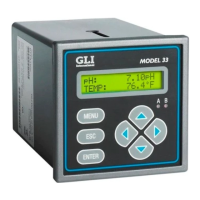Rev. 6-1100 Model P33 pH/ORP Analyzer (panel-mount 1/4 DIN)
1
OPERATING INSTRUCTION MANUAL
Model P33
pH/ORP Analyzer
(Panel-mount 1/4 DIN style;
selectable for pH or ORP measurement)
Worldwide Headquarters and Sales:
GLI International, Inc.
9020 West Dean Road
Milwaukee, Wisconsin 53224
U.S.A.
Represented By:
In the interest of improving and updating its equipment, GLI reserves the right to alter specifications to equipment at any time.
A company
Viridor Instrumentation
Phone:
Fax:
E-mail:
Web:
[414] 355-3601
[414] 355-8346
info@gliint.com
www.gliint.com

